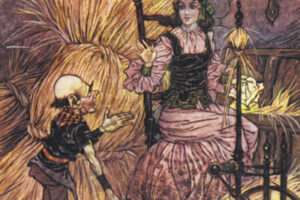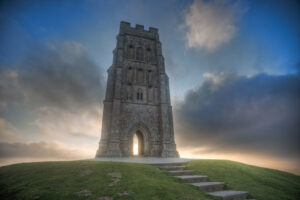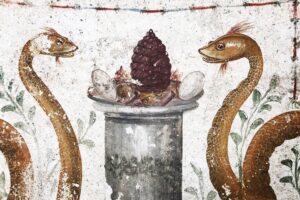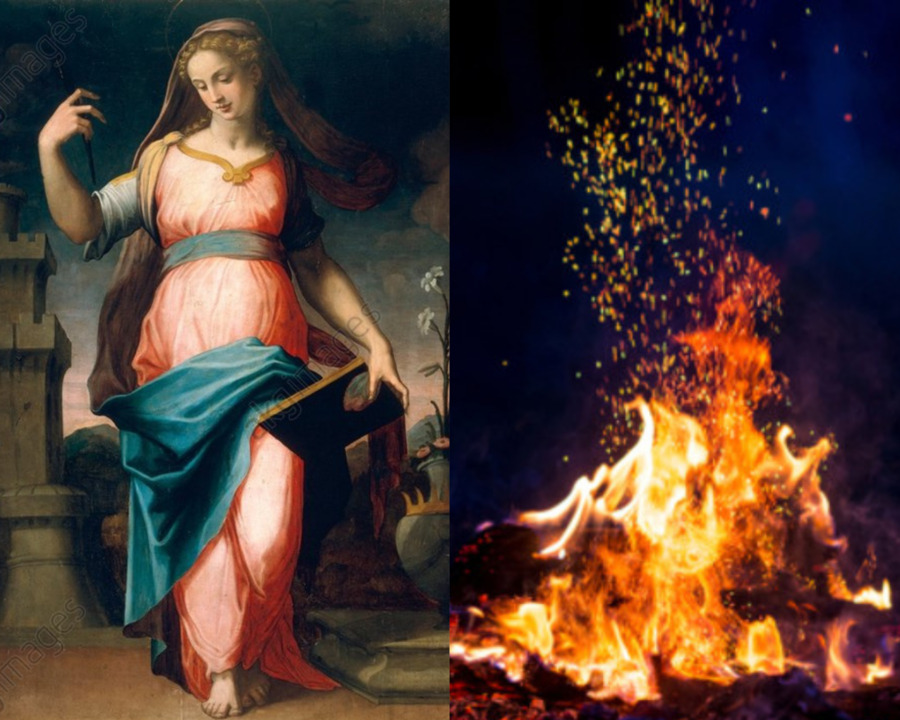
Saint Barbara, the sacred guardian of the hearth
Saint Barbara, the sacred guardian of the hearth
by Hasan Andrea Abou Saida
“Hestia, thou who tends the sacred house of Lord Apollo, He who strikes from afar, in the divine Pito, with sweet oil that always drips from thy hair, come now to this house, come, Thou who hast one mind with Zeus most wise, approach and grant grace to my song.” (Homeric Hymn to Estia)
Continuing the symbolic and esoteric exploration of the cult of saints, 4 December is the feast day of St Barbara, the Christian martyr of fire. In popular Christianity, she is venerated for her numerous patronages: she is the patron saint of firemen, artificers, sailors, artillerymen, engineers, miners, architects, masons, bell-ringers and umbrella-makers. Legends about the saint’s life are numerous and differ widely, casting doubt on her actual historical existence: in 1969 she was removed from the general Roman calendar. The most popular legend has it that Barbara was born in 273 AD in a city then called Nicodemia (present-day Azmit), a port in Turkey, and then moved around 286 AD to the rustic villa of Scandriglia, in the province of Rieti. Her father, named Dioscurus or Dioscorus, of pagan religion and collaborator of the emperor Maximian Herculeus, had his daughter locked up in a tower to protect her from the outside world and from her numerous suitors (whom she systematically rejected one by one). Furthermore, to prevent Barbara from going to the public baths, her father had private baths built in the tower. After seeing the plans for the construction of the tower, Barbara ordered the builders to add a third window, as initially there were only two, recalling the Christian Trinity. Shortly before entering the tower, the young girl also immersed herself three times in an adjacent pool, baptising herself. When her father discovered his daughter’s new faith, he went to the Roman magistrate, named Martinian or Martian, to denounce her. Barbara was thus condemned to be beheaded, and it was decided that the sentence would be carried out by her father Dioscurus after two days of ferocious torture. These began with a scourging with rods, which according to legend turned into peacock feathers (an attribute of the saint). The executioners tried to torture her with fire, but the flames burning at her sides were extinguished almost immediately; her breasts were then cut off, her head hit with a hammer, and she was paraded naked through the streets. Finally, her father led her to the top of a mountain and beheaded her. Descending from the mountain, Dioscurus was incinerated by lightning or fire from the sky as punishment for the murder of his daughter 1.
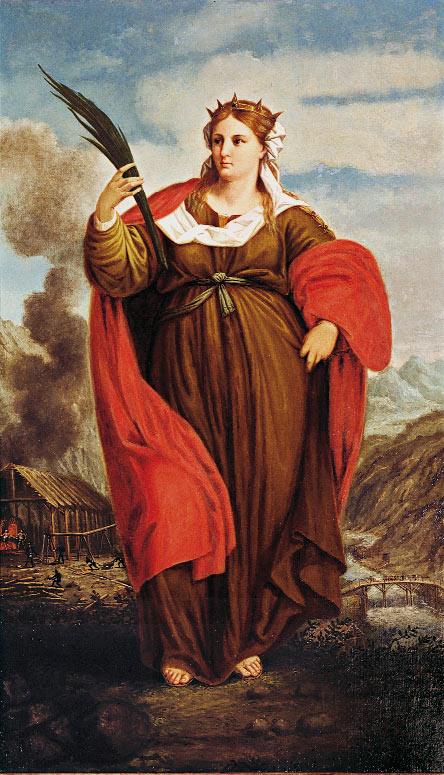
Analysing the legend and the attributes given to the saint, there are symbolic and analogical correspondences with an ancient Roman deity, the Bona Dea. Literally ‘the good goddess’, she was an ancient female divinity considered to be the sister, wife or daughter of Faunus and also called Fauna, Fanta or Oma. She was considered by the Romans to be the protector of fertility and prosperity, a Great Latian Mother whose name could not be pronounced. All the domestic arts were dedicated to her and her cult was celebrated exclusively by Roman women 2. The feast dedicated to the goddess was celebrated in the night between the 3rd and 4th of December, the same day dedicated to St Barbara, and took place in the house of the consul or the praetor: here he received a sacrifice and a libation from the magistrate’s wife, the matrons and the Vestals. The celebration was directed by the Vestals and no man was to be present during the feast inside the chosen house, which was decorated with vine shoots and other plants and flowers, except myrtle. The temple of the Bona Dea was located under the Aventine Hill and here too, in a sacred wood, women and girls celebrated the mysteries of the Bona Dea every year on the first of May, sacrificing a pregnant sow.
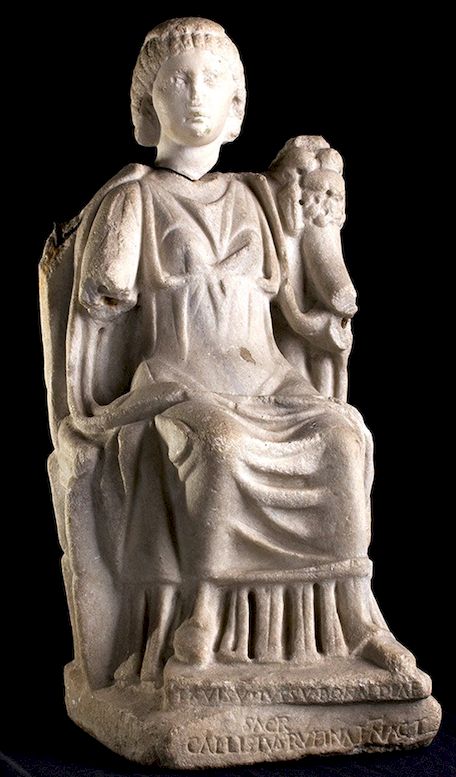
According to an episode very similar to that of St Barbara reported by the Roman writer Lactantius, one day the Bona Dea found a jug of wine in the house, drank it and got drunk. For disobeying, her husband Faunus chastised her with myrtle rods to such an extent that she died of it; this explains the exclusion of myrtle from her temple. According to another version, Fauna is the daughter of Faunus and would have resisted the wine and whipping with which her father wanted to force her to join him 3. St Barbara underwent the same torture, in which the rods were transformed into peacock feathers. The peacock is a symbol of death, resurrection and eternal life and was a sacred animal raised in temples. Whoever plucked a feather from it committed a sacrilegious act and could be punished with death. The peacock is also one of the animals sacred to Juno, the wife of Jupiter, and the Romans called it ‘Juno’s bird’ 4. According to some authors, the cult of the Bona Dea in Carthage was similar to that of Juno, called Iuno Caelestis, while in Rome she was represented with a sceptre in her hand just like Juno. For the ancient Roman religion, Juno was the female deity corresponding to the divine male aspect of Jupiter, and as such she is represented as the goddess of the atmosphere and rain, but also under the aspect of moon goddess, goddess of the calendar, woman, female life and fertility, and goddess of marriage 5. In the story of the saint, her father Dioscurus died, after putting his daughter to death, by a thunderbolt, an expression of Jupiter’s divine power.
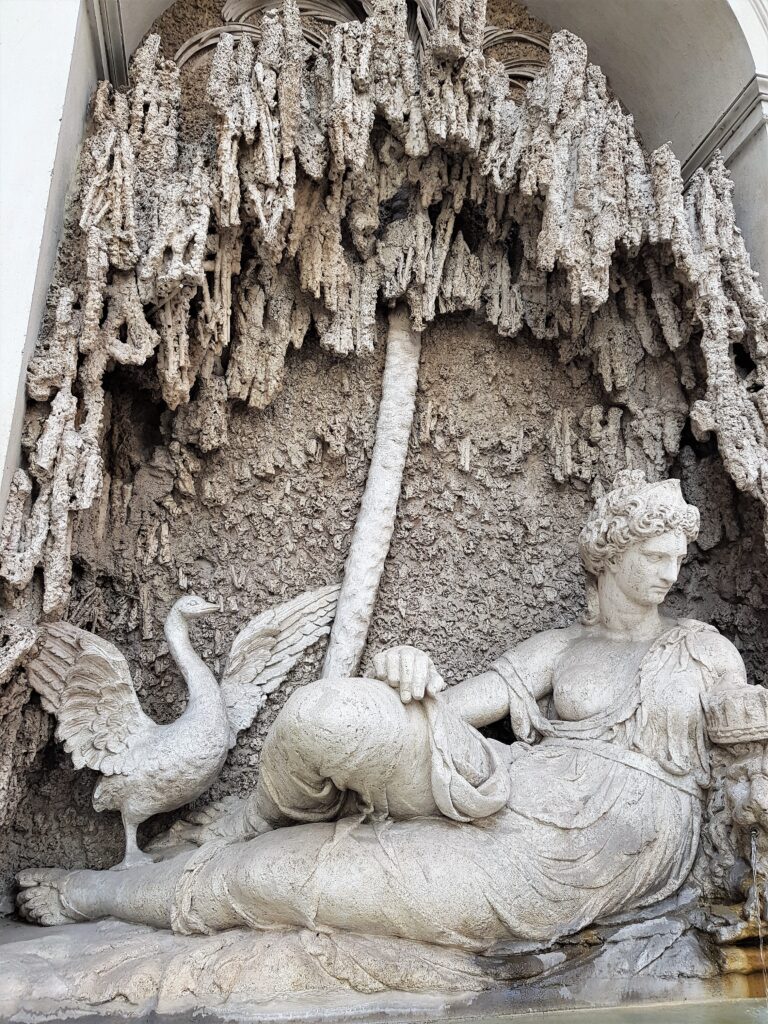
Myrtle has also always been associated with femininity as a symbol of fertility, a plant sacred to Venus and the Great Mother 6. The priestesses of ancient Rome who were entrusted with the cult of the Bona Dea were the Vestals, called virgines Vestales. This female priesthood dates back to very remote times in our Italic past. The Vestals were in fact virgin priestesses in the service of the goddess Vesta, the goddess of the public and domestic hearth. Their task was to guard the sacred fire of the goddess, lit inside the temple dedicated to her, ensuring that it never went out. The goddess Vesta is characterised by a substantial duplicity: on the one hand, in fact, she is the goddess who protects the city and the state, and the praetors, consuls and dictators offer her sacrifices before taking office; but at the same time she is identified with the domestic hearth that burns in the centre of every private home and around which the family gathers to eat. She is therefore the protector of domestic life, who keeps the members of the family together, to the point that every house and every hearth within it can rightly be considered a small sanctuary of the goddess, who shares with the Penates and the Lares the role of tutelary deity of the family. Inside the temple dedicated to the goddess, there was no statue of her, only the sacred fire, which was always kept burning. If the fire was accidentally extinguished, the Roman state would consider it a very bad omen, so the Vestal Virgins’ main task was to make sure that this did not happen. The Vestal Virgins who were guilty of negligently allowing the fire to go out were punished by flogging, which was inflicted by the pontifex maximus himself. The priestesses, over whom the Pontiƒex Maximus exercised the highest authority, were originally four in number, later to become six, chosen from girls aged between six and ten. Their service lasted thirty years: in the first ten they learned the art as novices; in the next ten they carried out their role to all intents and purposes; and in the last ten they trained the novices destined to take their place. They enjoyed considerable privileges and were emancipated from their father’s authority, but also had numerous obligations, including the obligation to preserve their virginity during their service: violation of chastity was punished by burying the offender alive 7.
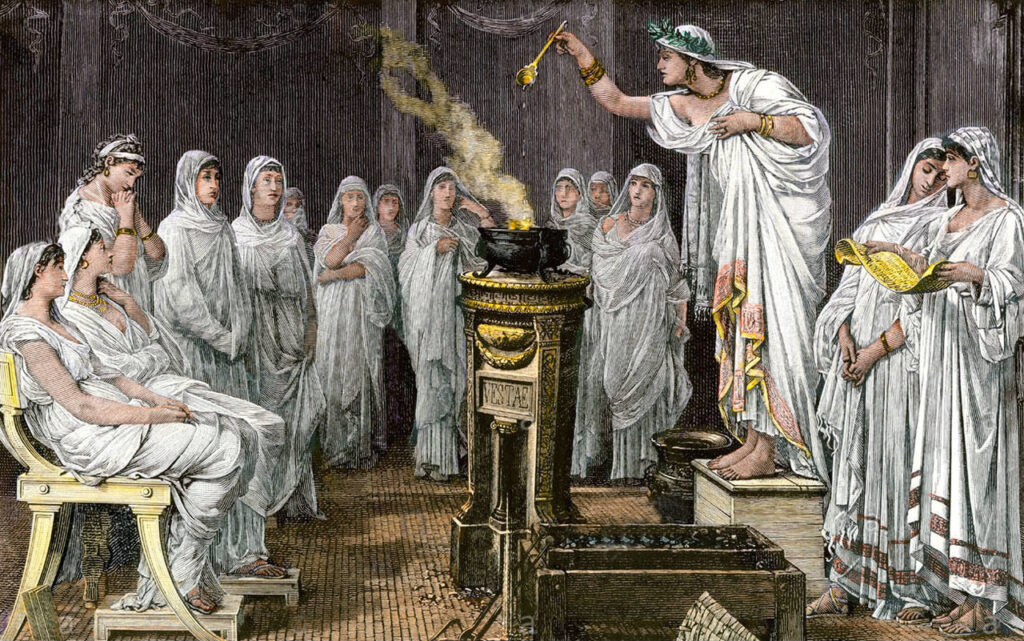
There is a clear similarity with the figure of St Barbara, who was also a virgin and was martyred by fire at the age of thirty-three, the same age at which a Vestal ended her initiatory journey to return to private life and marry. Moreover, the iconography and the clothes of the saint are very similar to the clothing of a Vestal and the Goddess Vesta herself. Observing the statues of Vestals found among the ruins of the Atrium Vestae in the Forum, one can see that the priestesses had their heads adorned with the vittae and the priestly infula and their hair gathered under the crines breasts, a kind of ceremonial wig, typical of matrons and forbidden to maidens and harlots. The head was often gathered in the suffibulum, which is nothing more than the veil ordinarily used in sacrificial rites, but which, according to some, is reminiscent of the red flammeum with which brides were veiled on their wedding day. The tunic was fastened to the waist with the so-called ‘Hercules knot’, as was the custom in the hairstyle of new brides 8. On the other hand, the Goddess Vesta was usually represented seated on a throne amidst libations and holding a stick called arbor felix, which was used by the Vestal Virgins to light the Sacred Fire 9. The same attire can be found in the iconography of St Barbara: her hair gathered into a matronly headdress, from which a fluttering ribbon departs, also reminiscent of the ribbons the priestesses wore in their hair; the brooch holding up her cloak and a fibula clasped around her waist.
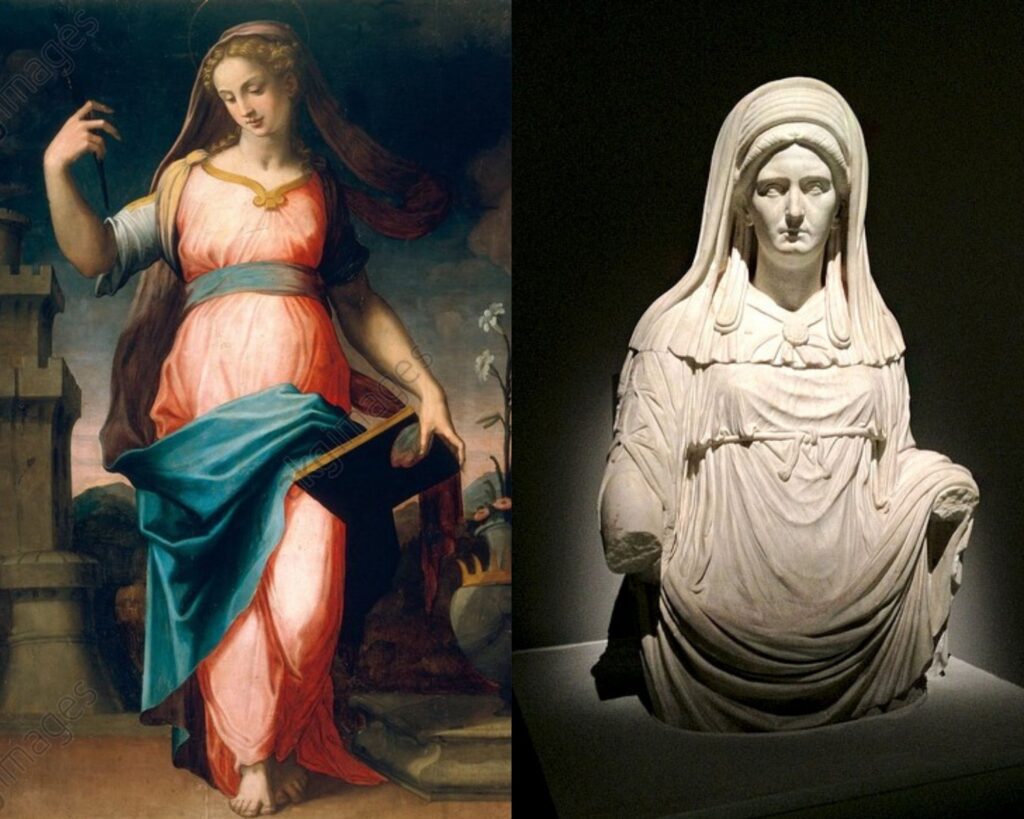
Among the traditional rural rituals performed on St Barbara’s Day, and in connection with the ancient practices of the Vestal Virgins, is the preparation of soups, cakes and buns made of wheat. On the evening of 4 December, in the churches of Kefalonia, a ceremony is held to bless a wheat soup to which sultanas, pomegranate seeds, walnuts, almonds, sesame, cinnamon, cloves and nutmeg are added: a hymn to fertility and abundance during the winter month. It is a soup with a strong propitiatory value, prepared at home by virgins and young unmarried women, as an ex voto to the saint, to help them find a husband. In Pontus (the ancient Pontus Eusinus, the granary of Hellas), a soup of wheat flour mixed with maize flour and beans called ‘varvara’ is prepared as a tribute to St Barbara. On 4 December, ‘pontiaki’ housewives also bake ‘melopites’, pancakes made of flour and chopped nuts, dipped in blond honey 10. The same rituals, aimed at propitiating the Great Mother and marriage, were celebrated by the Vestals with the offering of mola salsa, a sacred flatbread made of spelt flour, water and salt. The preparation of the mola salsa was extremely delicate and as such entrusted to the Vestals, who personally picked the ears of spelt to ensure that they were the first fruits. A particular use of spelt was linked to wedding rituals. The most solemn marriage was called confarreatio, for which no divorce was allowed, and which included in its ritual the offering of a spelt cake to Jupiter Capitolinus, which was performed by the bride and groom in the presence of the Flamen Dialis, the Roman priest in charge of the cult of Jupiter Capitolinus. Spelt is symbolically associated with Jupiter and was the most widely used cereal in the diet of the ancient Romans until the 5th century BC. 11. St Barbara, therefore, just like the goddess Vesta and the Great Mother, is associated with fertility, abundance and marital unions.
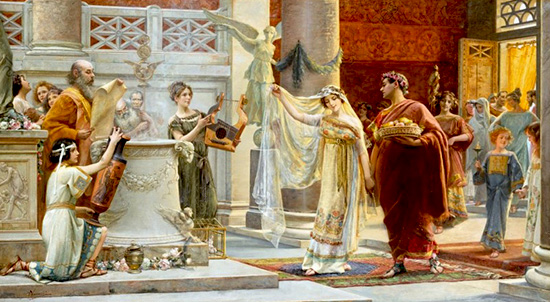
In ancient Greece, the deity corresponding to Vesta was the goddess Estia, goddess of the hearth in both private homes and public places. The name Estia in ancient Greek ῾Εστία means ‘hearth, fireplace, altar’. One of the earliest forms of the temple was the hearth; the early temples of Dreros and Prinias in Crete are of this type, as is the temple of Apollo at Delphi, which always had its own internal hestia. The Mycenaean great hall (megaron), like the hall of Odysseus in Ithaca described by Homer, had a central hearth. The goddess was the object of great veneration among the Greeks, not only because she is the mildest, most honest and most charitable of the Olympian goddesses, but also because she invented the art of building houses. According to tradition, Estia was the first-born daughter of the titanids Rhea and Cronus, and was therefore the first to be swallowed by her father Cronus. She was granted eternal virginity by Zeus, after rejecting Apollo and Poseidon as suitors. As the hearth was considered the centre of domestic life, Estia was considered the goddess protector of the home and family life, and was believed to reside in the inner, most intimate part of every home. Usually, responsibility for the domestic worship of Estia fell to the matriarch of the family, and rarely to a man 12. The name and functions of Hestia show the importance of the hearth in the social, religious and political life of ancient Greece. Estia was also offered the first and last libations of wine at feasts, and a small offering was always made before each sacrifice (‘Hestia comes first’) 13.
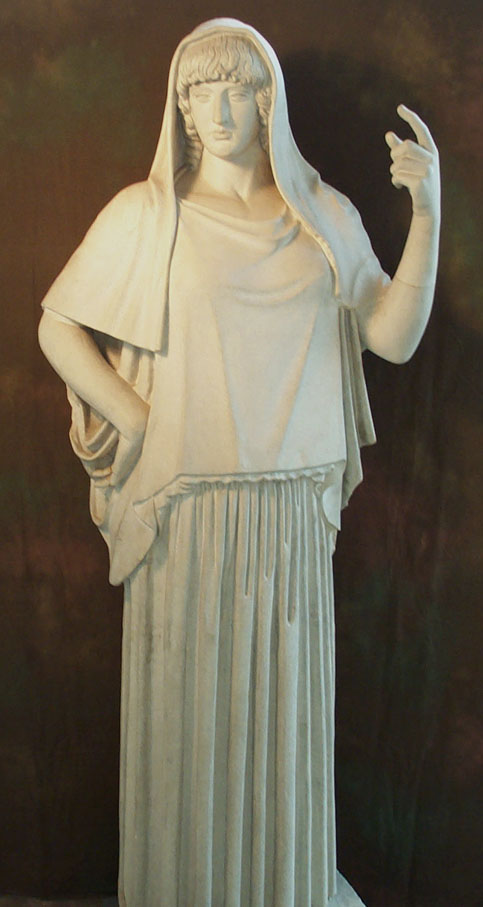
The hearth was therefore essential for warmth, the preparation of food and the completion of sacrificial offerings to the gods. It is the repository of the family’s long ontogeny, the place around which the gens gathers and makes it a direct descendant of heaven, the place where man’s material sustenance is prepared. The hearth was the first construction element to be used when building a house, around which the rest of the building, made of clay or unbaked or fired bricks, was built. Created as a simple central flame in primitive dwellings during the Neolithic period, surrounded by earth or stones, the hearth was associated with the presence of the protective spirits of the home and the community. In the matriarchal societies of ancient Europe, women played a fundamental role, not only as the leader and spiritual guide of the community, but above all as the sacred guardian of the hearth through which the Great Goddess, through ancient rites, revealed her will and the directions for the life of the entire community. Some of these rites are still performed today, such as the propitiatory offering of an oak log, called a ‘capodono’, in the hearth on Christmas Eve.
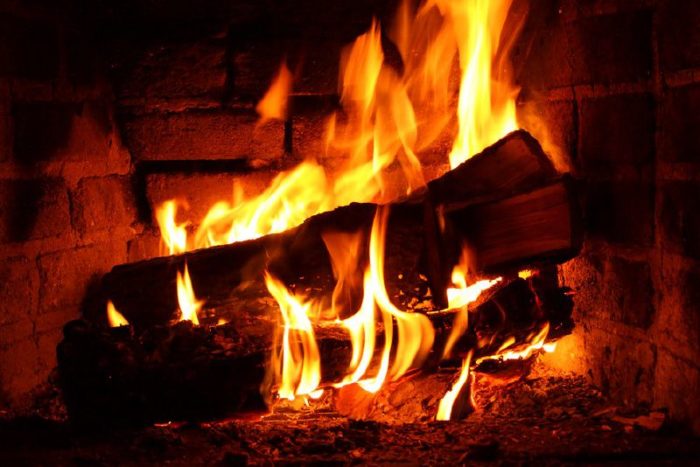
In conclusion, we have seen how Saint Barbara and the divinities of earlier pagan cults, such as the Roman goddess Vesta and the Greek goddess Estia, represent the female archetype of the sacred guardian of the hearth, heir to a millenary tradition from ancestral roots.
1 Cattabiani, A. (2013). “Barbara”, Santi d’Italia. Milano: Rizzoli.
2 Ferrari, A. (2015). Dizionario di mitologia greca e latina. Torino: UTET, p. 117.
3 Bona Dea. Treccani Enciclopedia online, https://www.treccani.it/enciclopedia/bona-dea/#:~:text=Bona%20Dea%20Divinit%C3%A0%20romana%20venerata,cerimonia%20erano%20banditi%20gli%20uomini.(last visit 03/12/2020).
4 Cattabiani, A. (2001). Volario: simboli, miti e misteri degli esseri alati: uccelli, insetti, creature fantastiche, Il pavone di Era e il pavone di Cristo. Milano: Mondadori.
5 Giunone. Treccani Enciclopedia online, https://www.treccani.it/enciclopedia/giunone/ (last visit 03/12/2020).
6 Cattabiani, A. (1998). Florario: miti, leggende e simboli di fiori e piante. Milano: A. Mondadori, p. 348.
7 Vestale. Treccani Enciclopedia online, https://www.treccani.it/enciclopedia/vestale_%28Enciclopedia-Italiana%29/ (last visit 03/12/2020).
8 Ibidem
9 Ferrari, A. (2015). Dizionario di mitologia greca e latina. Torino: UTET, p. 730.
10 Festa del grano per Santa Barbara 4 dicembre. Taccuini Gastrosofici.it, https://www.taccuinigastrosofici.it/ita/news/medioevale/usi-costumi/Santa-Barbara-del-grano.html (last visit 03/12/2020).
11 Ferrari, A. (2015). Dizionario di mitologia greca e latina. Torino: UTET, p. 319.
12 Estia. Treccani Enciclopedia online, https://www.treccani.it/enciclopedia/estia_%28Enciclopedia-Italiana%29/ (last visit 03/12/2020).
13 Burkert, W. (2019). La religione greca di epoca arcaica e classica. Milano: Jaca book, p. 332.

